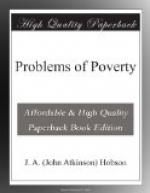It is easy to see how the worthless element from our villages, the loafer, the shiftless, the drunkard, the criminal, naturally gravitates towards its proper place as part of the “social wreckage” of our cities. But the size of this element must not be exaggerated. It forms a comparatively small fraction of the whole. Our city criminal, our city loafer, is generally home-grown, and is not supplied directly from the country. If it were true that only the worthless portion of our country population passed into our cities to perish in the struggle for existence, which is so fatal in city life, we should on the whole have reason to congratulate ourselves. But this is not so. The main body of those who pass into city life are in fact the cream of the native population of the country, drawn by advantages chiefly economic. They consist of large numbers of vigorous young men, mostly between the age of twenty and twenty-five, who leave agriculture for manufacture, or move into towns owing to displacement of handicrafts by wholesale manufacture.
Sec. 6. Effect of the Change on National Health.—This decay of country life, however much we may regret it, seems under present industrial conditions inevitable. Nor is it altogether to be regretted or condemned. The movement indisputably represents a certain equalization of advantages economic, educational, and social. The steady workman who moves into the town generally betters himself from the point of view of immediate material advantages.
But in regarding the movement as a whole a much more serious question confronts us. What is the net result upon the physical well-being of the nation of this drafting of the abler and better country folk into the towns? Let the death-rate first testify. In 1902 the death-rate for the whole rural population was 13.7 per 1000, that of the whole urban population 17.8. Now it is not the case that town life is necessarily more unhealthy than country life to any considerable extent. There are well-to-do districts of London, whole boroughs, such as Hampstead, where the death-rate is considerably lower than the ordinary rural rate. The weight of city mortality falls upon the poor.
Careful statistics justify the conclusion that the death-rate of an average poor district in London, Liverpool, or Glasgow, is quite double that of the average country district which is being drained to feed the city. We now see what the growth of town population, and the decay of the country really means. It means in the first place that each year brings a larger proportion of the nation within reach of the higher rate of mortality, by taking them from more healthy and placing them under less healthy conditions. In the case of the lower classes of workers who gravitate to London, it means putting them in a place where the chance of death in a given year is doubled for them. And remember, this higher death-rate is applied not indiscriminately, but to selected subjects. It




